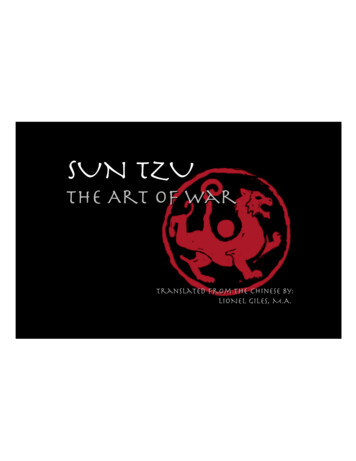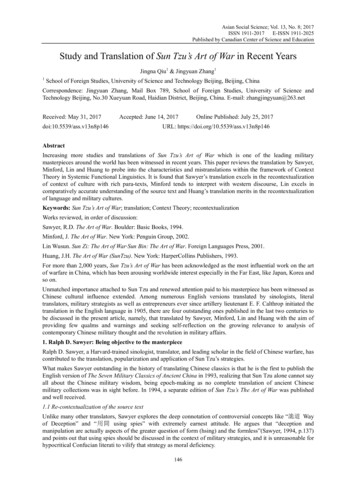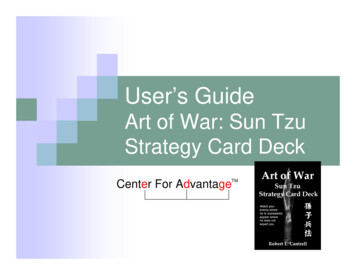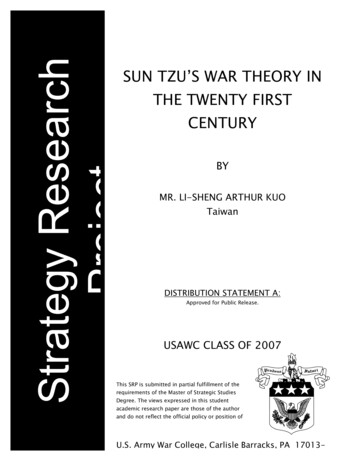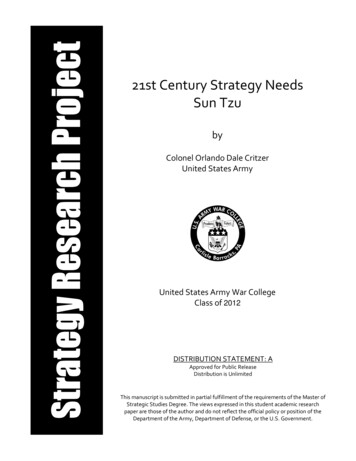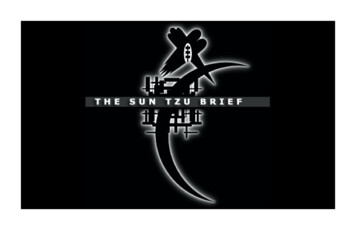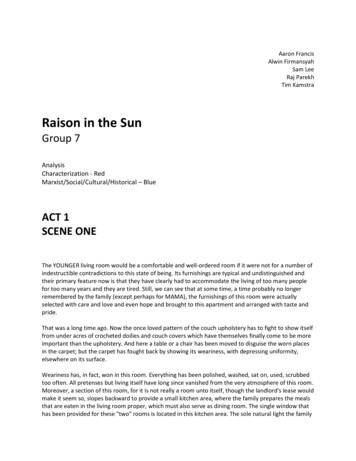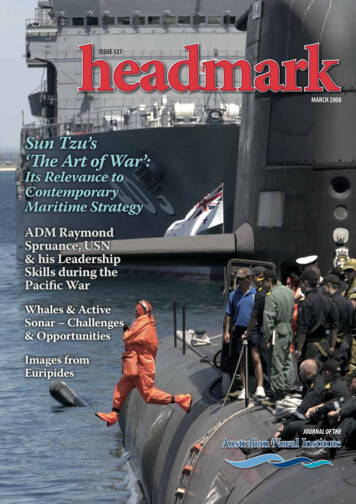
Transcription
ISSUE 127MARCH 2008Sun Tzu’s‘The Art of War’:Its Relevance toContemporaryMaritime StrategyADM RaymondSpruance, USN& his LeadershipSkills during thePacific WarWhales & ActiveSonar – Challenges& OpportunitiesImages fromEuripidesJournal of the
Welcome to the futureof naval maintenancePhotos courtesyof DefenceKBR's capabilities include ILS planning atthe conceptual stage of a projectApplying commercial best practiceto sustain complex maritime platformsand systemsJointly providing integrated materielservices to the RAN’s amphibious andafloat support shipsContactEmail: salesgoapac@kbr.comPhone: 1800 194 866K0709 09/07
President’s MessageMy first purpose is to extend anHeadmark, our office costs, staging the annualinvitation to attend the AustralianVernon Parker Oration and so on.Naval Institute’s Annual General Meeting inWe also have agreed that the ‘reserve’ ofthe Military Theatre of the Australian Defenceequity of the Institute should, as a principle,Force Academy at 1730 on Thursday 13equate to two years’ expenditure and that, asMarch.3ContentsSun Tzu’s ‘The Art of War’:Its Relevance to ContemporaryMaritime Strategy4Admiral Raymond Spruance,USN and his Leadership Skillsduring the Pacific War10President’s Message Continued 13The Ship’s Command Team& Network Centric Warfare15Front pagephotograph:we increase our activities, we should do so inOnly partly as an inducement for yousuch a way that our new calls on resourcesto join us, the meeting will be followed, bydo not prevent the accompanying increasekind permission of the Commandant andin equity. The Council is of the view thatthe President of the Mess Committee, by anthis principle should prevent a return to ourANI Reception at the ADFA Officers’ Messparlous financial situation of 2000-2001. Iat 1830. Apart from allowing members toshould add that, at our current – but only oursocialise, we also intend this as a recruitingcurrent – activity level, we are very close tomeasure – please feel free to bring a potentialachieving a two year reserve.ANI member as a guest. PLEASE PUT THISIN YOUR DIARY NOW!!If you are able to join us for the AGM and/The second requirement is therefore thatthe membership fees need to be increased toachieve the appropriate balance. I attach a tableor the start of year Reception, I would be veryof proposed fees. Several points may be made.grateful if you could let my office know, viaThe first is that this is the first increase in feesLieutenant Commander Aaron Nye or Cynthiain seven years and will move the individualKelly, on (02) 6275 6191, email Cynthia.Kelly@membership fee from 45 to 60. The second,customs.gov.auand this is associated with our next area forThe AGM will have some importantimprovement, is that we are providing fordecisions to make and I think it vital that youa junior membership fee, not only for fullhave the opportunity to consider their rationaletime students, but for persons of the rankbefore we bring any proposal to the floor.of Lieutenant or below, of 40 (less than theThe ANI Council have had the opportunitycurrent individual fee). We are also providingto consider our progress in relation to thefor a reduced fee to members who are fullyStrategic Plan which we adopted in 2005. I canretired from the work force. I should add thatreport that we believe that we have achievedwe are providing for multi-year membershipsome success, but that we think we need to dofor both categories and will have no concernsmuch better in three key areas, closely related.if a member should change status duringThe first, while we have considerablythat period. On the other hand, we will beimproved our equity very largely due to ahappy to consider a return of fees if a membergenerous program of sponsorship, is that theretires while holding a standard multi-yearlong term well being of the ANI demands amembership.better balance between the financial supportThese fee increases will not themselves beprovided by our membership and thatenough to support our equity requirements.provided by our sponsorship program. TheFor its own sake, also, our third area ofCouncil have adopted as a principle that thedevelopment needs to be an increase inmembership fees should be able to cover theindividual membership. It stands currentlybasic annual commitments of the Instituteat just over 300. The Council has set a targetwhich we do not regard as discretionary andof 200 additional members over the next fivewhich we regard as central to its continuedyears – requiring a net increase of 40 membersexistence. This would include, for example,a year.the production and distribution costs ofATIAUSTALAUSTRALIAN DEFENCE CREDIT UNIONBOOZ ALLEN & HAMILTON FRIENDEDSPresident’s Message continued on page 13 JACOBS AUSTRALIAKBRLOPACP&ORAYTHEON AUSTRALIASAABThe crew of CollinsClass Submarine,HMAS Collinsconduct abandonship drills alongsideFleet Base West.Royal Australian Navy Pilot Training 23& Aerial Hydrographic Surveyingin the 1920sWhales and Active Sonar– Challenges & Opportunities28Images from Euripides32RADM Bill Dovers Obituary36Australia’s Secret War– Ship Repairs38Visions from the Vault43Book Reviews44Style Notes for Headmark47ANI Events Program48ANI Online Guide49Printed by EverbestPrinting CompanyAustralian Naval Institute Info50ISSN 1833-6531ANI Membership Application Form51Design & DTP:Diane Bricknelldiartist@bigpond.net.auIssue Number 127Journal of the Australian Naval Institute
4Sun Tzu’s ‘The Art of War’: Its Relevance toContemporary Maritime StrategyBy Commander M A RazzakSun Tzu (535 BC), a General under theexperience relevant to contemporaryobjectives with the means to achieveEmperor He Lu of Wu State in China,maritime strategy, let alone navalsuch objectives in peace and in war.”5wrote The Art of War in 490 BC. Thisstrategy? A sceptical view tends toAccording to the Dictionary of Militarylegendary work first became known tosimmer as little reference of Sun Tzuand Associated Terms (US Departmentthe Western part of the world throughis found in the studies of maritimeof Defense 1987) strategy is “the artits translation into French in 1782 AD.strategy. In fact, Clausewitz is muchand science of developing and usingSince then, The Art of War has been inreferred in analysing the views ofpolitical, economic, psychological, andprint in different languages around themaritime strategists. For example,military forces as necessary duringworld and studied beyond militaries towhile evaluating Mahan’s maritimepeace and war, to afford the maximumthe political, diplomatic, business andstrategic thoughts, Geoffrey Till wrote,support to policies, in order to increaseintellectual circles. Sun Tzu’s views are“Essentially, Mahan built strategicallythe probabilities and favourabledebated, researched and applied in war.on existing ideas about maritimeconsequences of victory and to lessen“There is a legend that this little bookactivities, which were, as we have seen,the chances of defeat.”6 Liddell Hartwas Napoleon’s key to success and hislargely tactical in their approach, anddefines strategy “as the art of allocatingsecret weapon . Certainly Napoleonmade some attempt to situate navaland employing military means inused all of Sun Tzu to his ownthinking in broader context of thesuch a way that the ends of policy areadvantage to conquer most of Europe.strategic thinking represented by theachieved.”7 According to EncyclopaediaIt was only when he failed to followlikes of Clausewtiz and Jomini.”4 AnyBritannica, “Strategy, in warfare, theSun Tzu’s rules that he was defeated.”1way, examinations of strategic visionsscience or art of employing all theJames Clavell was moved so much byand historical events in light of Sunmilitary, economic, political and otherthe inner thoughts of the book thatTzu’s philosophy keeping in mind theresources of a nation to achieve thehe stated, “I truly believe that if ourthoughts of maritime strategists canobjects of war.”8military and political leaders in recenthelp to find an answer to the question.Warfare, Sun Tzu described as ‘art’.times had studied this work of genius,With this short introduction thisClausewitz described, “ the artVietnam could not have happened asessay aims to examine the relevanceof war is the art of using the givenit happened; we would not have lostof Sun Tzu’s The Art of War tomeans in combat; there is no betterthe war in Korea (we lost because wecontemporary maritime strategy. Theterm for it than the conduct of war.”9did not achieve victory); . and, in alleffort begins with attempts to develop“The art is applied drawing onprobability, World Wars I and II woulda relational concept between strategyscience, which is to say drawing onhave been avoided – certainly theyand philosophy. Then it ascertainsknowledge.”10 Knowledge increaseswould not have been waged as theyrelational dynamism between thethrough education. The Art of Warwere waged; ”2components of maritime strategyimparts philosophical educationThis superb book in 13 chapters is- both military and non military.for the orchestration of means to“ so encompassing that it almostFinally, the essay makes a comparativeachieve military objective for aseems to predict the emergence ofexamination between The Art of Warpolitical end. Philosophy is “ theair and space power when it says,and components of maritime strategycritical examination of the groundsmetaphorically, “the expert on thewith special reference to naval strategicfor fundamental beliefs and analysisattack strikes from out of the highestelements.of the basic concepts employedreaches of the heavens.” It is also3acknowledged that this archetypalwork of Sun Tzu is one of the mostinfluential works in kinds and degreesStrategy and Philosophy:A Relational Conceptin the expression of such beliefs.Philosophical inquiry is a centralelement in the intellectual history ofmany historical civilizations.”11in military theories and studies.“Strategy generally denotes theDespite these facts, there remainsdesign and implementation of a planthe basic tenets of conducting wars.a natural question; is this two and afor the coordinated employment ofStrategy grows on those basics andhalf thousand years old philosophyresources with the aim of attainingmodified with the changes in thebased on Sun Tzu’s soldieringassigned objectives. Strategy links theambient factors of peace and war.Journal of the Australian Naval InstituteThe Art of War gives insight into
5Issue 127On the other hand, such factors canthe naval planners and commandersby Stratagem does not say how to makeinfluence little the philosophicalto evolve favourable strategy withan attack. It is rather an insight intosayings based on ‘critical examinationflexible option as Sun Tzu said, “Havingtargeting enemy objects and taking fullof the grounds for fundamental beliefspaid heed to my assessment of theadvantage of it depends on commandand analysis of the basic concepts.’ Forrelative advantages and disadvantages,which, according to Sun Tzu, is aexample, Sun Tzu’s five factors (the way,the general must create a favourable“matter of wisdom, integrity, humanity,heaven, earth, command and rules andstrategic situation which will helpcourage, and discipline.”regulations) on ‘Making Assessments’bring the victory to fruition. By this Isubtly suggests “to compare two sidesmean being flexible and making thein terms of above factors and appraisemost of the advantages to gain thethe situation accordingly.” Then it is forinitiative in war.”12 Similarly, AttackingReview Political DecisionStrategicDecisionInputFiltrationSources ofStrategic CapabilityNaval StrategyOutputNaval MissionGovernment ’sEconomicPerformanceElementsFactorsTo win, keep, contestWar ValueMilitaryPower FunctionTrade ProtectionDistant OperationGDPDefence BudgetNon-military IssuesPoverty AlleviationHealth LogisticsRepair SourceBattleFleet in BeingActivePassiveSea Control/SeaDenialInfluencing ContinentalWarProtection of TradeProtection of Off ShoreAssetsPolicingFishery ProtectionSuppression DrugTraffickingAnti SmugglingPollution ControlCrime PreventionDiplomatic/NavalPresence MissionNegotiationManipulationPrestigeNaval Share of DefenceBudgetPoliticalPublic Sentimenttoward DefenceExpenditureHumanTacticsJudgemental ErrorDoctrinal ErrorCrew EnduranceCrew Efficiencyor ignore use of seaBlockadeOpen DistantClosePeacetimeContribution toNational EcomonySupport PoliticalResolveEssential ConsiderationsResource, Balance of Power in Employment, Excellencein Warfare, Strategic Advantage, Speed in War, Machineand Warfare, Economy of Effort and Resource, Mobilityof Means, Simple and Flexible Strategy, Initiative in War.Relational Dynamism between Components of Marine StrategyJournal of the Australian Naval Institute
6Sun Tzu’s ‘The Art of War’:Its Relevance to Contemporary Maritime StrategyComponents of MaritimeStrategy: RelationalDynamismsimultaneously in peace and war, asthe course ofit has been. Relational dynamismthe war. “Outbetween the two divisions of maritimeof the total 451strategy and their components aresurface warships“Maritime strategy concerns the useshown in the flow diagram at the end ofand submarinesof the sea for support of national orthis article.in commissionalliance policies in peace and war. Suchduring the war,strategy encompasses the maritime332 had been sunkaspects of war as well as security intime of peace.”13 According to JulianCorbett, “By maritime strategy wemean the principles which govern awar in which the sea is a substantialfactor. Naval strategy is but that part ofThe Art of War andComponents of MaritimeStrategy: ComparativeExaminationby the time Japansurrendered andonly 37, or 8.2percent remainedoperational.”20Resource Factor in MaritimeStrategy.Balance of Power andthe fleet when maritime strategy hasdetermined what part the fleet mustResource is the single most importantAchieving maritime objectives throughplay in relation to the action of the landcomponent of maritime strategythe employment of military resourceforces; ”14 The definitions discloseand extremely contributory to itsdemands the determination of balancethree basic constituents of maritimedevelopment and application. Resourceof power. “Factors in the art of warfarestrategy – objective, obtaining theof the state has a limit to spare forare: First, calculations; second,means to achieve objective andits forces. Economy of resource isquantities; third, logistics; fourth,principles governing the application ofcritically important for sustainablethe balance of power; and fifth, themeans. Maritime strategy in today’sforce transformation and for providingpossibility of victory. Calculations arecontext is, therefore, rephrased assustenance to operations. Admiralbased on terrain, estimates of availableorganizing, protecting, managing andVern Clark hopes the US Navy toquantities of goods are based on thesesecuring the movements of nationalinvest savings from Sea Enterprise incalculations, logistical strength is basedlogistics over the oceans in responsetransforming the navy into the 21on estimates of available quantities ofto conflicting demands of peaceCentury.goods, the balance of power is based onit which determines the movements ofstEmployment of Military Means.War costs a nation hugely. “Helogistical strength, and the possibilitytechnological, social, psychological andwho wishes to fight must first countof victory is based on the balance of(national) logistical and military factorsthe cost.”15 “In joining battle, seek thepower.”21are the components of warfare.quick victory. There has never beenand war where political, economic,The Battle of Atlantic during WWa state that has benefited from anII was primarily a battle to draw, keepunveil two fundamental divisionsextended war.”16 “. if the campaignand contest the balance of powerin maritime strategy, which areis protracted, the resources of thenon-military and military aspectsState will not be equal to the strain.”of logistics. For Axis German it was aof the strategy. Non-military featureThese philosophies indicate interactivebattle to destroy 600,000 to 750,000includes population, politics, oceanrelation among national resource,tons of British shipping per month fortrade, technology, economy, maritimelogistical strength and the balance ofa year to force UK to sue for peace.22area, oceanography and maritimepower. History also reveals that, “ The Falklands War showed how theinfrastructure. These are also thevictory went to the power best able toconsideration for balance of powersources of military dimension ofproduce and organize materials andimpacted the preparation for war. Themaritime strategy i.e. naval strategy.manpower for war.” During WWII,terrain for the naval dimension of theNaval strategy focuses on securing thethe US Navy had 67, 952 ships of allFalklands War which can be referredinterest in the use of the sea. Militarytypes on 30 June 1945 compared toto as “the fall of the land, the proximateand non-military components of1099 on 30 June 1940.19 On the otherdistances, difficulty of passage, themaritime strategy succeed throughhand, Japan was unable to makedegree of openness, and the viabilitymutual support. They are activegood the losses she suffered duringof the land for deploying troops”23 wasAbove definitions and explanationsJournal of the Australian Naval Institutethrough the destruction/protection1718ADM ChuichiNagumo,Japanese Navy
7Issue 127quite unfavourable to the UK leading tobombers on deck and returning aircraftThe strategic advantage that Japanhuge preparations to draw the balancefrom Midway in the air. Further,gained through its surprising actionof power in favour. Then, keeping theevasion tactics enforced on Nagumo’sagainst the USA on 7 December 1941balance in favour went further into theforces by US torpedo bomberswas short lived, yet, expanded Japanesesuperior application of combat power.prevented him from launching aircraftinfluence over the South PacificIt is both superior concentration andon deck and also prevented him fromrapidly. Then, the combination ofapplication of combat power that maderecovering returning aircraft runningsurprising actions and straightforwardthe difference in the Pacific duringout of fuel.28 Japan’s losses in the battleoperations by the US forces acrossWW-II, the Falklands War and theof Midway due to Nagumo’s ignorancethe Pacific resulted in the capitulationnaval aspects of Arab-Israel Wars. It isof defence were the beginning of anof Japanese Forces. The Indiana vital consideration for the successfulend.Navy’s (IN) innovative attack onemployment of the US Navy’s SeaKarachi Harbour in December 1971Power 21. Hence, Sun Tzu’s saying hasExcellence in Warfare.and straightforward operations inrelevance that number alone confers noWining a war is certainly a matter ofthe Bay of Bengal established INadvantage.excellence. Sun Tzu said, “. to windominance at sea. “Surprise anda hundred victories in a hundredstraightforward operations give risebattles is not the highest excellence;to each other endlessly just as a ringthe highest excellence is to subdueis without a beginning or and end.”32Warfare.the enemy’s army without fightingIn today’s technological environmentSun Tzu’s saying that the possibilityat all.” The expression is explicitlystraightforward operations may beof victory lies in attack is valid inrelevant to maritime strategy affairs.difficult proposition but surprising24Offence and Defence: TheResultant Value in Naval29naval warfare. In the history of naval“Since 1945 there has been one realaction will remain an importantwarfare none emerged victoriousnaval war, half a dozen rather one-element in maritime warfare. Towithout offensive actions. Sun Tzu alsosided naval contributions to operationsachieve strategic advantage throughemphasized on defence to avoid defeaton land, and more than 200 politicalsurprise, a naval commander shouldto achieve victory. “Being invincibleapplications of limited naval force.”consider innovation, speed and targetlies with defense, the vulnerability ofHistory of maritime strategy revealsprioritization.the enemy comes with the attack.”that ‘political application of limitedOffensive and defensive actions havenaval force’ achieved maritimeSpeed in Naval Warfare.complementary roles. “. Attack isobjectives more than the recourse“War is such that the supremethe secret of defence; defence is theto naval engagements, which can beconsideration is speed”, said Sun Tzu.33planning of an attack.” “In battle,credited with the “highest excellence”.In narrower outlook it is the timing ofthere are not more than two methodsLatest in the series of ‘excellence’ wasan attack. In wider sense it is the totalof attack - the direct and indirect; yetthe US securing Pakistan’s supportspeed of means of war. Admiral Clarkthese two in combination give rise tofor its war on terror. Prior to the USattached great importance to the needan endless series of manoeuvres.”27invasion of Afghanistan after 9/11,for speed for different components ofNagumo’s ignorance of defence duringUS threat to employ naval power toSea Power 21. Thinking of speed forthe attack on Midway in 1942 severelysend Pakistan back to the Stone Age,strategic advantage should be viewedaffected Japanese Forces in the Pacific.peacefully secured Pakistan’s support.in whole system perspective. A ship’s252630After the first air attack on Midway,speed available for action should behe concentrated more on offensiveGaining Strategic Advantage.viewed as the total speed of wholeactions. Nagumo rearmed his torpedoMaritime history has many accountssystem aboard. A fleet’s speed forbombers for ground attack, which wereof gaining strategic advantage throughaction should also be looked atkept in defence against US surfaceintelligent combination of ways andsimilar perspective. During theforces. When Spruance’s carriersmeans. “For gaining strategic advantageGulf War of 1991, the US successwere sighted, Nagumu was unable to(shih) in battle, there are no morein transporting 8.3 trillion kilogramlaunch immediate strike. On the otherthan “surprise” and “straightforward”war material in five months 8500hand, Spruance’s torpedo bombersoperations, yet in combination, theymiles away from the mainland andcaught Nagumo’s carriers with groundproduce inexhaustible possibilities.”31subsequent quick victory is creditedFleet AdmiralChester Nimitz withbinocularsJournal of the Australian Naval Institute
8Sun Tzu’s ‘The Art of War’:Its Relevance to Contemporary Maritime Strategyto total speed. In the context ofSpeed in manoeuvre adds agility.”39without disaster.43 “ whatcurrent maritime asymmetric threat“Physical mobility directly affectsenables the wise sovereignenvironment, speed is also criticallythe deployment of force. This isand good general to strike andimportant to tackle the fundamentalespecially critical when the distancesconquer, and achieve thingsproblems for maritime forces operatingfrom the basing and staging area arebeyond the reach of ordinaryin the littoral ‘where the battle spacelong and the forces must be deployedmen, is foreknowledge.”44is compressed into a much smallerat short notice.”40 The concept ofIn narrower conceptspatial area, reaction time is less andmobility extends beyond the physicalforeknowledge is tactical inmanoeuvring space is limited’.movement of forces. “The availabilitynature. In wider sense itof highly mobile and effective meansincludes enemy’s military34Economy of Effort andof fire power enhances the movementstrategic information, nationalResource.capabilities of one’s forces Mobilitycharacter and culture, economy andFor the purpose of economy ofalso means communication. Withoutpolitical resolve/vulnerability. Prior toresource and effort target prioritizationreliable communication throughoutPearl Harbor disaster, Rear Admiralis important. “ the best militarythe chain of command, firepower andKimmel asked his Fleet Intelligencepolicy is to attack strategies; the nextspeed of movement mean little.”41Officer about the location of Japaneseto attack alliances; the next to attackcarriers. The officer replied that he didSimplicity and Flexibility insoldiers; and the worst to assaultnot know.45 And the consequence ofwalled cities.” An understandingMaritime Strategy.not knowing the enemy is known toof the philosophy helps prioritizingSimplicity and flexibility are essentialthe world. Contrarily foreknowledge oftarget and weighing relative benefit ofattributes of maritime strategy and alsothe Japanese forces enabled Nimitz totargeting. During the attack on Pearlfound in the principles governing wars.maintain the initiative and take the leadHarbor on 7 Dec 1941, “. Nagumo,Plans to achieve maritime objectivesin the Pacific during the WW-II.fearing a counter attack, made a criticalmust be simple and flexible. Knowledgemistake by refusing to launch a thirdof the following five essentials forwave on the harbour’s repair facilitiesvictory42 together with factors onand fuel installations, which would‘Making Assessments’ can produceThis essay examined significanthave destroyed Pearl as a base.” Insimple and flexible maritime strategy.incidents from the contemporary3536the battle of Coral Sea (4-8 May 1942),Admiral Nimitz targeted the Japanesea. He will win who knows when tofight and when not to fight.Concluding Remarksmaritime history and futuristicvisions to find relevance of Sun Tzu’smain invasion force destined for Portb. He will win who knows howThe Art of War to maritime strategy.Moresby that could isolate Australia.to handle both superior and inferiorExaminations revealed that despiteHe left the invasion of Tulagi andforces.being the work of Sun Tzu’s soldieringLouisiade unopposed. Although thec. He will win whose army isexperience, the relevance of The Artbattle ended in confusion and lossanimated by the same spirit throughoutof War extends beyond land warfareon either side, Allied forces could foilall its ranks.into maritime warfare. It can guideJapanese landing on Port Moresby.37Mobility: Value in NavalWarfare.d. He will win who, preparedinvaluably to formulate, materializehimself, waits to take the enemyand apply maritime strategy. Lastunprepared.but not the least; the fundamentale. He will win who has militaryconcept for the US Navy’s operationalMobility is an essential component ofcapacity and is not interfered with byeffectiveness – Sea Strike, Sea Shieldmaritime strategy. Napoleon’s battlesthe sovereign.and Sea Basing are found to be thedepended upon mobility. It is oneexpanded transformation of Sunof the things that Sun Tzu stresses.Initiative in Naval Warfare.Tzu’s thoughts on attack, defence andNaval forces without mobility andInitiative is the key to achieveessentials for operational mobilitymanoeuvrability are ineffective andobjectives. Initiative originates fromattributed to evolutionary changes ininefficient at sea. “Mobility assuresknowing the enemy and knowingthe international political set ups andmanoeuvrability in tactics andone’s self. Such knowledge enables atechnological advancement in a timeflexibility to adjust to the changes.commander to fight a hundred battlesspan of 2500 years. 38Journal of the Australian Naval Institute
9Issue 127Commander Mohammad AbdurRazzak, BN, was commissioned intothe Bangladesh Navy on 1 June 1984.He graduated from Defence ServicesCommand and Staff College (DSCSC),Bangladesh and attended NavalWar Course in Turkey in 1999-2000and 2001-2002 respectively. He hashad a number of papers published inBangladesh Armed Forces Journal,Journal of Bangladesh Institute ofInternational and Strategic Studies,Mirpur Papers (Journal of DSCSC),The Naval Review, UK and in the USA’sProceedings. He was the “SecondHonourable Mention” winner in theInternational Navies Essay Contest2000 organised by the US NavalInstitute. Presently he heads theSchool of Logistics and Management,Bangladesh Navy.(Endnotes)11 Lieutenant Hewitt underwent RAAFpilot training in the same scheme asKennedy. He later transferred to the RAAF,rising to the rank of air vice marshal. SirRichard Williams, These are Facts; TheAutobiography of Air Marshal Sir RichardWilliams KB CB DSO (the Australian WarMemorial and the Australian GovernmentPublishing Service), Canberra, 1977, p. 144.BIBLIOGRAPHYBooksThe Art of War by Sun Tzu, Edited andforeword by James Clavell, Hodder &Stoughton, London, 1981.The Book of War (Sun Tzu The Art ofWarfare & Karl Von Clausewitz On War),The Modern Library, New York, 2000.Sunzi: The Art of War Sun Bin: The Art ofWar, Edited and translated into modernChinese by Wu Rusong and Wu Xianlin,translated into English by Lin Wusum,Foreign Languages Press, China, 2001.Carl Von Clausewitz, On War, Edited andTranslated by Michael Howard and PeterParet, Everyman’s Library, UK, 1993.Geoffrey Till, Seapower A Guide for theTwenty-First Century, Frank Cass Publisher,UK, 2004.Richard Harding, Sea Power and navalwarfare, 1650-1830, UCL Press, UK, 1999.The Oxford Companion to the Second WorldWar, Oxford University Press, New York,1995.International Military and DefenseEncyclopedia, Vol-3 (pp.1131-1135) Vol-4(pp. 1657-1662) and Vol-5 (pp.2573-2577),Brassey’s (inc) USA, 1993.The New Encyclopedia Britannica, 15thEdition, Volume-9 (p. 388), Volume-11(p-305), USA, 1997.Magazines/JournalsCdr M A Razzak, Bangladesh Navy, ‘Windsof Change Reshaping Principles of War’, TheNaval Review, UK, Vol. 94, No. 2, May 2006,pp. 124-131.Richard Scott, ‘Scourge of the Sea’, Jane’sDefence Weekly, Vol. 41, Issue No. 43, 24October 2004, pp. 19-23.The Art of War by Sun Tzu, Edited andforeword by James Clavell , Hodder &Stoughton, London, 1981, p. 11.2 The Art of War by Sun Tzu, p. 7.3 The Book of War (Sun Tzu The Art ofWarfare & Karl Von Clausewitz On War),The Modern Library, New York, 2000, p.xxiii.4 Geoffrey Till, Sea Power A Guide forthe Twenty-First Century, Frank CassPublishers, UK, 2004, p.40.5 International Military and DefenseEncyclopedia, Vol
objects of war.”8 Warfare, Sun Tzu described as ‘art. ’ Clausewitz described, “ the art of war is the art of using the given means in combat; there is no better term for it than the conduct of war.”9 “The art is applied drawing on science, which is to say drawing on knowledge.”10 Knowledge
